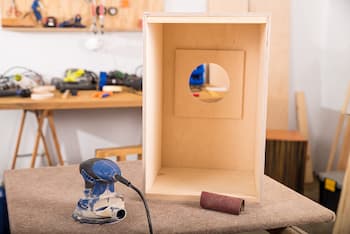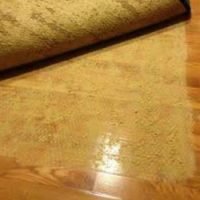A drum sander is one of the effective tools used to sand wood floor surfaces. The sanding is a refinishing of wooden floors for a flat surface. But, the main problem is drum sander marks on the hardwood floors due to heavyweight, uneven wheels, and improper sand grit paper.
The machine scratches the floors badly and ruins its beauty.
What Is Drum Sander?
The fundamental disc machine for sanding hardwood flooring is the sander, and it is utilized on most of the floor. This sander is worked from a standing position.
In any case, the sander can’t get exceptionally near the walls and corners, so to do the border of the room, you want to switch over to the edger, a 7″ measurement turning rough plate that is worked from a stooping or twisted around the position.
Dewalt Palm Sander Review
It is one of the best sanders with smooth motion as compared to the older one. The locking dust port tends to completely control the vacuum hose around the floor. Now get rid of marks, gouges, dents, and staining with a natural orbit device.
The foam pad creates a flatten sanding plan on engineered hardwood flooring. The 2.3 AMP motor comes to repair hardwood edges floors with the least floor marking. Now, enjoy slick floor sanding by choosing and getting this repairing tool on oak floor finish and hardwood flooring.
Pros of Dewalt
- Highly durable and versatile
- Improved paper clamp
- 14000 OPM
- Solid look
- Provide the best result for years
Cons of Dewalt
- Dust bag not appropriate
The product rating is 4.8 out of 5
What Type Of Marks Produced?
The imperfection in operation and entire equipment fitting cause stains and marks. Plus, the machines are responsible for scuffed and stained floors.
Two types of marks appeared:
- Orbital marks
- Swirl marks
How does A Sander operate?
- Read each step carefully and use the sander as you need for the sanding process.
- Introduce a sleeve of rough over the sanding drum, focus it cautiously, and close the entrance entryway. Ensure the residue pack is tied around the exhaust pipe.
- Associate the machine to a suitable grounded and combined circuit. 20-amp circuits (generally found in kitchens or restrooms) are ideal.
- Roll the sanding machine to your beginning position (corresponding to the sections of the floor, with a divider to your nearby left, and somewhere between the front and back wall).
- Ensure that the sanding drum control switch is in the ‘up’ position and that the sanding drum isn’t in touch with the floor. Turn the selector change to the beginning (S) position. Once began, permit change to get back to the run (R) position.
- Feather cut-in: start pushing ahead, all the while moseying the sanding drum down onto the wood floor with the control switch.
- While the sanding drum is also completely drawn in with the wood floor delivery control switch and changes your speed for satisfactory stock evacuation. However, keep your speed consistent consistently. Keep the sander moving while at the same time sanding drum is locked in with the floor or stop imprints will happen.
- Move the machine toward the grain whenever the situation allows. Sand the wood floor at a consistent, purposeful speed.
- Bit by bit feather cut-out toward the finish of your pass by facilitating the sanding find with the control switch. Stun the end focuses for a superior mix while edging or sanding.
- Continuously press selector change to off (O) position and quickly disengage the machine from the power supply while supplanting rough, purging substance of residue sack, or while sanding activity is finished.
- Void residue sack at whatever point it is 1/3 full. Never leave a residue sack unattended with sanding dust in it. Sanding residue can unexpectedly light and cause a fire or blast.
- Void residue into the clean plastic pack, seal firmly and store away from floor structures. Never incorporate stain-or dissolvable absorbed clothes into the pack with the floor sanding dust.
How To Avoid and Fix Chatter sanding Marks On The Hardwood Floors?
Using worn or damaged sandpaper; skipping sandpaper grits or setting the sanding speed too fast or too slow, or using excessive drum pressure may all cause sending marks on sanded floor areas.
Change sanding discs frequently, replacing them as they get worn or dirty is the perfect option for stain-free wood floors. Listen for a flapping sound when sanding as a right indication of improper paper tension, and tighten the loose side as possible.
Probably, tighten the V-belts before starting the sander, and loosen them before long breaks to reduce wood floor vibration. When you’re fine-sanding, set the floor sand device to the lowest setting and avoid propelling down or pulling up on the sanding marks device on the wood floor.
Features To Consider While Selecting For Wood Floor
Just take care of some features before buying for hardwood floor.
1. Sawdust
The sanders with huge dirt cups may keep the hard coarse grains during finishing. It is really important for any high-quality cleaner.
2. Clamps
The different clamps bring to set it in an upright position on the floor. It avoids stain and gouge-floor with a belt, orbital, and swirl.
3. Trigger lock
The lock will allow operating on the floor without pressing the ON button. You prepare and begin the random work on the hard-to-reach minimal corner. It makes the many homeowners’ life easy to pass the buffing.
The contractor uses this type of lock for applying finishes and spots.
Drum Sander Marks On Hardwood Floors-Final Thoughts
If sander marks hardwood floors, put a common grit paper in the best way for stain-free hardwood floors. The process with old sand grit caused scratches on the hardwood floors. For refinishing or floor finish, use a floor sander and edger.
The refinishing sand grit papers do not leave scratches on the wood floors. If you may use step-by-step sanded operation guidelines, never left the floor finish sand scratches on the hardwood floors. The grit paper will be best for removing stains and scratches on wood floor areas.
Make your hardwood floors stain-free with the best refinishing type.
The hardwood floor will need proper supervision during refinishing and sanding the hardwood floor to avoid scratches and stain marks. The right decision will protect the wood floor and wood finish from stains.
Hope So, you will get the answer that
Why or how sander marks on hardwood floors during sanding
Contents



![Can You Use Thieves On Hardwood Floors? [My Experience] Can You Use Thieves On Hardwood Floors](https://cutefloor.com/wp-content/uploads/2022/03/Can-You-Use-Thieves-On-Hardwood-Floors-200x200.jpg)

![How To Use Johnson Paste Wax On Hardwood Floors? [My Way] How To Use SC Johnson Paste Wax On Hardwood Floors](https://cutefloor.com/wp-content/uploads/2022/03/How-To-Use-SC-Johnson-Paste-Wax-On-Hardwood-Floors-200x200.jpg)
